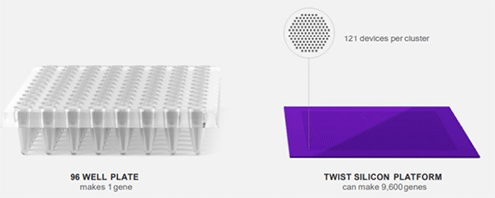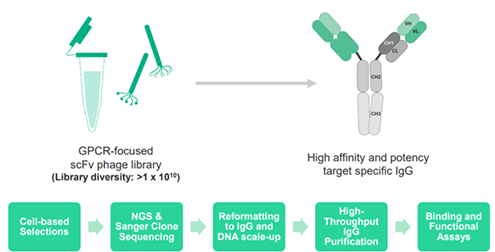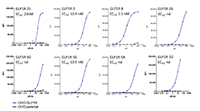Antibody Development Made Easier with Synthetic Biology
Pharmaceutical Technology's In the Lab eNewsletter
Synthetic biology can help researchers circumvent the challenges of traditional methods of antibody generation.
Antibodies are versatile tools that support the life sciences in many ways, including detection assays, diagnostic tests, and therapies for cancer and other diseases. Perhaps their most important use is as tools in the drug discovery process. Antibodies have high diversity, which is made possible because of the recombination of the V(D)J sequences, a unique set of genes that can create nearly 300 billion different antibody variations (1). This diversity is both a benefit and a drawback because, even though there are a number of antibodies to choose from for an antigen of interest, finding the right one can be a labor-intensive endeavor that is expensive and time-consuming. To complicate matters, not all of the billions of combinations are viable, either because the complementary antibody cannot be formed through V(D)J recombination, or the combination, itself, is possible, but the resulting antibody has too low of an affinity to be clinically useful.
This is a constant challenge with antibody-based studies. In fact, many antibody therapeutics fail in the preclinical phase (2). This has led to the concept of “developability,” which conveys the readiness of a certain antibody for therapeutic use in terms of design, development, and manufacturing.
With recent advancements in synthetic biology, however, new techniques are being developed that can augment current antibody discovery protocols to help design and construct antibodies with greater developability for a range of previously undruggable targets.
The GPCR dilemma
The best example of a difficult antibody target is the G-protein coupled receptor (GPCR)-the largest family of receptor proteins primarily involved in cell signaling. They have been implicated in diseases ranging from Alzheimer’s to breast cancer, thus making this target class an attractive target for therapy. In fact, 34% of all FDA-approved drugs target these receptors (3). Yet, to date, only two drugs are anti-GPCR antibody therapies: erenumab and mogamulizumab.
The design and development of anti-GPCR antibodies are difficult primarily because of their general transmembrane structure. GPCRs are integral membrane proteins, so a lipophilic portion of the protein is hidden inside the cell membrane, and only a small area is exposed extracellularly. That concealed portion is unavailable to target with antibodies, and its lipophilic nature means that the protein’s native structure is hard to isolate and maintain in the lab during studies (4).
Of the nearly 800 GPCRs discovered, about 56% of them remain “undruggable” (3,4). This represents a large, untapped therapeutic potential that would not only pave the way for various therapeutic options for serious diseases, but also enable assays and analytical techniques that can further the understanding of GPCRs.
Current antibody development techniques
There are two major antibody development techniques being used today: hybridoma and naïve immune phage display, each with its own advantages and disadvantages.
Hybridoma generation is the older of the two techniques and generally produces highly sensitive antibody binders due to in-vivomaturation and selection. Mice, or other animals, are exposed to the antigen, or immunized, and splenocytes or lymphocytes (specifically B cells) from the animals are fused with myeloma cells (immortal B-cell cancer cells) to produce hybridomas. The hybridomas are plated and then screened for binding to the antigen. The ones with desired antigen-binding criteria are then selected. Hybridomas require a longer development time, with the entire process taking anywhere from six to eight months, while candidate antibodies potentially going into therapeutic use must undergo humanization steps.
In contrast, naïve immune phage display is conducted outside of a living system. A library of antibody sequences is built, then amplified using PCR and introduced into Escherichia Coli (E. Coli)through a bacteriophage. The bacteria then produce antibody fragments that are screened for desired binding. Candidate binders are then converted to full-length antibodies. Phage display is able to produce large quantities of antibody in a short period of time (typically a few months), and the libraries can be generated from any species, including humans, though this process is more expensive than hybridoma development.
Another drawback of the phage display method is the antibody libraries themselves. The DNA for the libraries results from reverse-transcription of the RNA from peripheral blood mononuclear cells (PBMCs). When PCR is used to amplify the DNA libraries during development, its error-prone nature can introduce errors into the libraries. In addition, phage display antibodies generally exhibit weaker affinity than those generated through hybridomas, which ultimately results in reduced developability. As such, many phage-derived antibodies require downstream affinity maturation.
Finally, a common disadvantage to both methods is that some epitope sites on targets may be difficult to generate antibodies against. This reduces the control researchers have over the final product and also limits the epitopes that can be targeted, including those on GPCRs. Fortunately, by utilizing synthetic biology, researchers can circumvent this challenge.
A “Twist” on phage display libraries
By leveraging its silicon-based DNA synthesis platform, Twist Biopharma, a San Francisco, CA-based biopharmaceutical company, has developed a variation of the phage display technique, which uses artificially produced naïve libraries that are synthesized from oligonucleotide (oligo) pools on a silicon chip. Unlike traditional naïve immune phage display, these libraries are designed using genetic information from publicly available databases, instead of PBMCs. Synthetic phage display libraries provide two advantages:
- Allow researchers to precisely define and control the synthesis of high-diversity domain libraries that can be directed towards epitopes previously not targeted
- Shorten the time from lead identification to functional antibody validation by rapidly synthesizing genes.
Moreover, synthetic libraries offer greater control over the sequences being used during construction. Researchers have direct control over the amount of variability that is introduced in the libraries and what sequence motifs are included. Challenges to quality-including stop codons, cryptic splice sites, and nucleotide restriction sites-are removed during this process when desired, giving more flexibility and creativity in what the effective sequence space entails, opening the possibility of designing libraries that can target difficult proteins like GPCRs.
Synthetic libraries also bring efficiency improvements that contribute to potentially shorter timelines from lead identification to antibody validation. Twist uses semiconductor-based DNA synthesis to “write” millions of oligos in one run on a silicon chip. The chip miniaturizes the reaction volumes by a factor of 106and increases throughput 1000-fold. One chip can synthesize 9600 genes, compared to one gene on a traditional plate (see Figure 1). It is not just the number of oligos that matter, the length does as well. The oligos used for these libraries can be up to 300 nucleotides long, providing more flexibility in the sequence design.
Figure 1. A comparison of the structure of a 96-well plate and the silicon chip used to synthesize the synthetic libraries. The miniscule clusters allow synthesis of millions of oligos into 9600 genes on one chip.

Use of synthetic antibody libraries for phage display is a proven approach (Figure 2). Guselkumab is an antibody drug on the market that treats psoriasis, and it was developed using fully synthetic phage display libraries. In addition, there are other approved antibody drugs which were developed using semi-synthetic libraries, including avelumab, sintilimab, and lanadelumab-which are used to treat conditions varying from solid tumors to angioedema.
Figure 2. The workflow of phage display antibody development using synthetic libraries.

DNA synthesis technologies have improved since the introduction of these drugs, and more likely than not, they will continue to improve. The scale and efficiency of current synthetic biology tools and the genetic data being used to construct diverse synthetic libraries in this manner were not available even just a decade ago. These advancements intertwine to overcome the developability issues commonly associated with phage display by allowing a level of control and speed that was not possible before.
The modified phage display process
The first step in developing a naïve synthetic antibody library is to analyze genetic sequence data gathered either through internal studies or from publicly available databases. That sequence information is then modified based on the needs of the target epitope. These libraries are then expressed in bacteriophages, ready to be screened against the target.
Phage panning can be done against soluble or cell-based antigens. Cell lines can be generated expressing cell-surface targets. These cells are selected and exposed to the bacteriophages. After five rounds of panning, where the plates are washed and unbound phages are removed, only phages that contain the single-chain variable fragments (scFV) that bind to the target remain. Each round of panning and selection is followed by clonal enrichment and verification using next-generation sequencing (NGS), which helps find functional binders.
The remaining phages are sequenced, and uniquely paired heavy chain and light chain variable (VH/VL) sequences are selected and converted to full-length immunoglobulin G (IgG) antibodies. These IgG antibodies are then subjected to kinetic binding assays and other biophysical characterization experiments.
Once the desired antibodies are selected, the sequences can be modified through an optimization platform (Twist Antibody Optimization Platform, Twist Biopharma, San Francisco, CA), which can improve properties of leads, such as affinity, half-life, and “developability”. For example, using the optimization platform, the affinity of a commercially available PD1-inhibiting antibody was increased by 72 times (5).
The overall process is similar to traditional naïve immune phage display. The major differences are in the creation of the antibody libraries, the reduction of optimization cycles following library synthesis, and the shortened timeline of discovery.
Applying synthetic libraries to GPCRs
As a proof-of-concept, this synthetic phage display method was used to develop antibodies that could bind to GPCRs, specifically the glucagon-like peptide-1 receptor (GLP1R), which is involved in blood sugar control and insulin secretion. Unlike traditional phage display libraries, synthetic libraries do not rely on random mutagenesis to create antibodies against GLP1R.
Although antibodies may have a tough time binding GPCRs, there are many ligands and peptides (cytokines, peptides, extracellular domains, and loops) that naturally bind to them. By studying the sequences of these natural binders and incorporating them into the synthetic libraries, antibodies against GLP1R can be designed, which are not available biologically with other methods.
Known GLP1R-binding ligands and peptides were analyzed, which revealed more than 100,000 binding motifs (6). These motifs were engineered into the complementarity-determining region 3 (CDR3) loop of the antibodies. After a displayability analysis, the structures of the antibodies were modeled, and the final library was optimized to reflect the rules of the natural human repertoire and to improve expression, affinity, and stability. Ultimately, this discovery process revealed more than 10 billion different variations in the library (6).
The libraries were incorporated into phage display libraries, which then underwent five rounds of selection against a GLP1R-stable Chinese hamster ovary (CHO) line. NGS clonal enrichment was monitored at each round, and from the picked 1000 clones, more than 100 unique VH/VL pairs were ultimately selected for conversion to full-length antibodies (6). After a purification step, the antibodies were analyzed by flow cytometry assay to test cell binding affinity. Functional assays, including 3′,5′-cyclic adenosine monophosphate (cAMP), b-arrestin, and internalization assays, were also conducted (Figure 3).
CLICK FIGURE TO ENLARGE. Figure 3. Results of flow cytometry (FACS) for the FACS-positive antibodies, along with the EC50 measurements.

Fifteen antibodies were found to positively bind GLP1R on cells and several of these antibodies displayed unique GPCR-binding motifs in their CDRH3s. These antibodies were IgG monomeric, were not prone to aggregation, and had affinities in the nanomolar range. Most importantly, the antibodies also exhibited low non-specific binding comparable to commercial antibodies as determined by baculovirus particle (BVP) binding assay. This meant faster serum clearance and increased likelihood of becoming a suitable drug candidate (6.7). These antibodies were determined to be good candidates for optimization using the optimization platform (Twist Antibody Optimization Platform, Twist Biopharma, San Francisco, CA) to modify the sequences for improved functionality and developability.
Conclusion
As shown through the anti-GLP1R study, synthetic biology can be a viable solution to many of the challenges associated with drug discovery and antibody development.
By focusing on an antibody’s effective sequence space and incorporating precisely-defined sequences from natural binders, antibodies against specific targets can be generated that were previously unattainable. Moreover, optimizing selected antibodies to improve affinity and manufacturability increases the likelihood of candidate antibodies progressing through the clinical drug development pipeline to ultimately become a new medicine. This translates into newfound therapies for hard-to-treat diseases and increases the diversity of treatment options.
References
1. B. Alberts, et al., “The Generation of Antibody Diversity,” in Molecular Biology of the Cell (Garland Science, New York, 4th ed., 2002).
2. J. C. Almagro, et al., Frontiers in Immunology 8, 1751 (2018).
3. A. S. Hauser, et al., Nature Reviews Drug Discovery 16, 829–842 (2017).
4. M. Jo and S. T Jung, Experimental & Molecular Medicine 48 (2), e207 (2016).
5. A. Sato, “Synthetic DNA Technologies Enable Antibody Discovery and Optimization,” presentation at PEGS: The Essential Protein Engineering Summit (Boston, MA, 2019).
6. P. Garg, et al., “A High-Throughput Platform to Develop Highly Potent and Functional Antibodies against G-protein Coupled Receptors,” TwistBioscience.com, 2019.
7. I. Hötzel, et al., mAbs 4 (6), 753–760 (2012).
About the author
Aaron Sato*, asato@twistbioscience.com, is vice-president of Protein Engineering at Twist Bioscience and chief scientific officer of the company’s drug discovery division, Twist Biopharma.
*To whom correspondence should be addressed.

Drug Solutions Podcast: A Closer Look at mRNA in Oncology and Vaccines
April 30th 2024In this episode fo the Drug Solutions Podcast, etherna’s vice-president of Technology and Innovation, Stefaan De Koker, discusses the merits and challenges of using mRNA as the foundation for therapeutics in oncology as well as for vaccines.
Drug Solutions Podcast: Applying Appropriate Analytics to Drug Development
March 26th 2024In this episode of the Drug Solutions Podcast, Jan Bekker, Vice President of Business Development, Commercial and Technical Operations at BioCina, discusses the latest analytical tools and their applications in the drug development market.